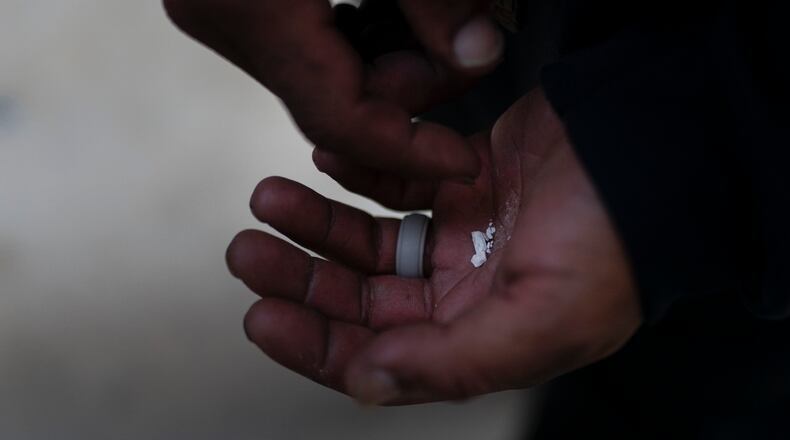“Collectively, the federal litigation settlement is about $19 billion of those five federal litigants,” Boyko said.
This settlement is part of the federal multidistrict litigation going on in Cleveland. She told the Journal-News at this juncture it is hard tell how much money the county will receive, since the dollar amounts and payout terms are different for each defendant.
“There are multiple variables in reaching settlement with the entities through the federal litigation,” she said. “To calculate exactly the amount Butler County will receive is difficult because of those variables.”
The county joined the multidistrict litigation after the commissioners sued 20 drug makers and distributors in federal court in 2017, they sought $5 million in that lawsuit. There are other defendants still on the hook in that giant litigation.
This settlement is completely separate from the $26 billion deal brokered by states attorneys general with the three largest opioid distributors Cardinal, McKesson and AmerisourceBergen and manufacturer Johnson & Johnson. Nearly 4,000 jurisdictions nationwide filed lawsuits in state and federal courts years ago when the heroin epidemic was killing their residents, and budgets trying to deal with the pervasive problem.
OneOhio stems from investigations by Attorney General Dave Yost and other state attorneys general into whether the three distributors fulfilled their legal duty to refuse to ship opioids to pharmacies that submitted suspicious drug orders and whether Johnson & Johnson misled patients and doctors about the addictive nature of opioid drugs.
He negotiated on behalf of all the governmental jurisdictions in the state including counties, cities and others. Most Butler County jurisdictions signed onto the settlement. The global settlement was divided based in part on things like number of overdoses and other demographics.
The county received the first $232,669 installment of OneOhio funds last summer and a second payment of $244,523 this year from the agreement with the distributors. Officials say they should receive a total of $3.8 million to $5.4 million over 18 years, depending on a host of variables. Plus they have access to a share of $38.1 million to $54.4 million more, as part of regional group of seven counties that will decide future funding distributions.
The county has received a total of $275,728 — allocations for the first two years — from the J&J settlement which means there is a total of $752,920 available to spend now and $4.8 million to $6.4 million over several years, not including the larger sums to be shared with the other counties in the regional group, from OneOhio.
The county also settled with Meijer for a one-time $150,000 payment.
How to spend the money?
The commissioners have not committed any of the opioid money yet, but Commissioner Don Dixon told the Journal-News given that the payout is over such a long period of time — and part of the massive litigation has been in bankruptcy court — they must be circumspect when making funding decisions. He said “first we have to come up with plan for where it has the most impact” but also consider contingencies.
“It’s very hard to make a plan if you don’t have the money in hand, you can say well check’s in the mail, it might be, it might not,” Dixon said. “Whatever we use it for, however we schedule it to be used for whatever services, we’re going to have to be cognizant of the fact there is no guarantee ... We’ll move on the assumption the settlement will be coming, we have to plan accordingly so we don’t commit to something that four or five years from now we can’t do.”
The COVID-19 pandemic kind of overshadowed the opioid epidemic but the addiction problem has not dissipated. According to statistics from the Butler County Coroner’s Office overdose deaths hit a high of 232 at the peak of that crisis in 2017, dropped to 159 in 2019 but numbers have been creeping back up, with 170 as of the end of last November.
Scott Rasmus, executive director of the Butler County Mental Health and Addiction Recovery Services Board, said the problem is still very real. He said the local committee — that is working to make recommendations for how the regional money should be spent — are targeting three areas: prevention/education, treatment and recovery.
“Overdoses have gone up this past year and the need is great and opiate/stimulant and other drug epidemic as it’s evolving is dynamic,” Rasmus said. “It’s important for us to address it in a dynamic way also, because it’s every changing and the need is great.”
How about other jurisdictions?
The cities, villages and townships have also received settlement money from the OneOhio program, although to a much lesser degree than the county. Hamilton and Middletown have received the largest amounts so far in the first two installments at $189,264 and $163,026 respectively.
Hamilton Finance Director Dave Jones said they have been told over the course of the OneOhio agreements they can expect to receive a total of $1.17 million to $1.68 million.
He said they were notified of the CVS group of defendants’ settlement but didn’t have any other information. He said no decisions have been made on how to the spend the money but it “has been set aside in a fund created just for the settlements.”
Missy Knight, communications manager for Middletown, said they have not received any information about Meijer or J&J and are still discussing how to spend their funds, “Middletown is evaluating internally how best to use the money for maximum benefit of the community.”
It appears West Chester Twp. is one of the only jurisdictions that has definitely decided specifically where to put the funds. So far the township has received $104,000 and expects to receive $714,475 total. Officials plan to spend it on “first responder mental health programming initiatives”, according to Barb Wilson, director of public information and engagement.
West Chester Trustee Mark Welch said “we’re getting the money, it’s mana from heaven” and he believes taking care of their own people — who have had to deal with the opioid issues front and center — is a good way to spend the money.
Oxford City Manager Doug Elliott said they have received $22,233 so far and expect to get some funds from the CVS litigation. They have some ideas for the money.
“The city administration has not made a recommendation to city council for the use of this money,” Elliott said. “One option that has been discussed is to utilize this funding to offset the cost for the recently hired social service liaison in the Police Division.”
Tiny Trenton is also using their funds on first responders. Finance Director Matthew Mesisklis said they have received $11,649 so far and expect to only receive an additional $85,000 to $90,000 over the next 16 years.
“Since the individual annual payments are rather small and spread out over such a long time, we do not have specific plans or programs for the money,” he said “But are putting it toward general fire and police operations, which include safety equipment, drug and resuscitation materials, and training.”
About the Author

